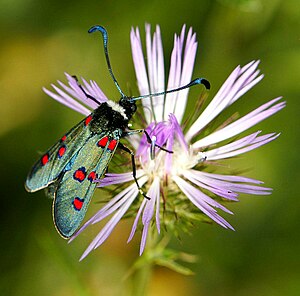Zygaena lavandulae
| Zygaena lavandulae | ||||||||||||
|---|---|---|---|---|---|---|---|---|---|---|---|---|

Zygaena lavandulae |
||||||||||||
| Systematics | ||||||||||||
|
||||||||||||
| Scientific name | ||||||||||||
| Zygaena lavandulae | ||||||||||||
| ( Esper , 1783) |
Zygaena lavandulae is a butterfly ( moth ) fromthe ram family (Zygaenidae). The species was named after lavender ( Lavandula ), a food plant for caterpillars.
features
butterfly
The wingspan of the moth is 31 to 37 millimeters. Their forewing upper side is black and provided with five red spots, which are bordered with thin black and are relatively small compared to other red ram species. Depending on the incidence of light, the wings shimmer with varying degrees of metallic greenish or bluish tones. The upper side of the hind wings is usually blackish in color and has two red spots that sometimes merge into one another. The thorax and abdomen are solid black. The collar is conspicuously bushy white. The antennae are thickened club-shaped at the tip.
Caterpillar
Adult caterpillars of Zygaena lavandulae have a gray basic color and are slightly hairy. Yellow spots stand out next to the very broad black secondary lines of the back. The stigmas are black in color.
Similar species
The similarly colored Zygaena rhadamanthus is clearly distinguished by six large red spots on the upper side of the forewing.
Occurrence and habitat
The distribution area of Zygaena lavendulae extends from northwest Africa and the Iberian Peninsula through southern France to Liguria . The main habitat are hot, sandy dry habitats, light forests, poor grasslands and sunny mountain slopes. The following subspecies are known:
- Zygaena lavandulae consobrina
- Zygaena lavandulae espunnensis
- Zygaena lavandulae barcelonica
- Zygaena lavandulae alfacarica
Way of life
The diurnal moths fly in one generation between March and July, depending on the altitude. They like to visit different flowers to take in nectar. The main food of the caterpillars are the flowers of rod wound clover ( Anthyllis cytisoides ) as well as the cheek clover species Dorycnium pentaphyllum and lavender ( Lavandula ). The boat-shaped, whitish to ocher-brown cocoon is irregularly ribbed. It is placed close to the ground between plants or on dead stems or branches.
Individual evidence
- ^ Arnold Spuler: The butterflies of Europe . tape 2 . E. Schweitzerbartsche Verlagbuchhandlung, Stuttgart 1910, p. 162 .
- ↑ Markku Savela: distribution. In: Lepidoptera and some other life forms. Retrieved March 21, 2020 .
- ↑ a b c Josef J. de Freina, Thomas J. Witt: Die Bombyces und Sphinges der Westpalaearktis, Volume 3, Zygaenoidea: Zygaenidae , EFW Edition Research & Science, Munich 2001, ISBN 3-926285-04-4 , p. 259 -261.
literature
Josef J. de Freina, Thomas J. Witt: Die Bombyces und Sphinges der Westpalaearktis, Volume 3, Zygaenoidea: Zygaenidae , EFW Edition Research & Science, Munich 2001, ISBN 3-926285-04-4
Web links
- Lepiforum e. V. - Taxonomy and photos
- pyrgus.de - Butterflies and their ecology
- inaturalist - flight time

